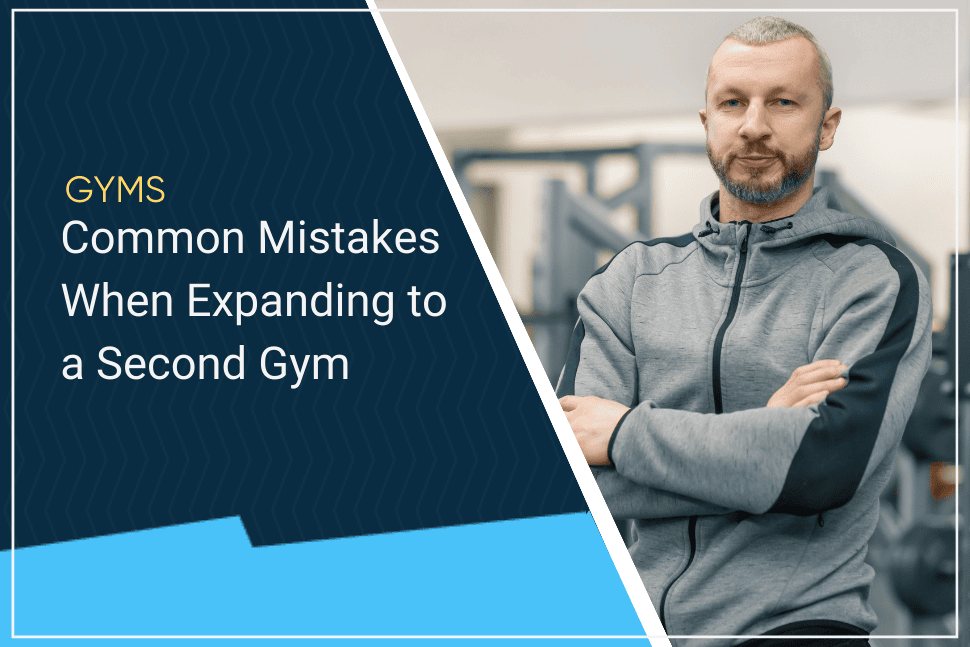When Is the Right Time to Open a Second Gym Location?

You’ve established a loyal following of gym members, your classes are full and your team runs smoothly. After years of grinding and perfecting your systems, you’re finally experiencing the success you used to only dream about.
Now what?
When you’re a successful gym owner, there comes a time when you ask yourself when to start a second gym location. It seems like the natural next step. But there are risks that come with opportunity…
- Has your business actually created something that is ready for scale?
- Are you using the right expansion strategy for your gym?
- Should you create from scratch or think about buying an existing gym?
These are not insignificant questions. When to launch a second gym location is one of the most critical decisions you can make as a fitness entrepreneur. Get it wrong, and you could cut your impact and revenue in half.
The right gym expansion strategy will depend on your market, model, and mission.
In this article, we’ll cover:
- The signs you’re ready to grow.
- How to evaluate your market and operations
- Key leadership and financial planning considerations
- Real fitness business growth ideas that work
- The pros and cons of scaling gym operations through acquisition versus new builds
- Buying an existing gym vs building a new gym
Whether you’re toying with the idea of opening a second gym location or honing in on what comes next, this guide will help you answer the big question: Is now the time to expand — or should you wait?
Why You Should Clarify Your Purpose Before Expanding
Before you jump into real estate listings or budgeting spreadsheets, take a step back and ask yourself the most important question: Why do I want to open a second gym location?
Momentum carries far too many gym owners away—the classes are full, the money is flowing, so we need to expand, right? Yet, without a clear goal, what may seem like forward motion can easily morph into a major headache, or at worst, a huge financial mistake.
Opening a second gym shouldn’t simply be an exercise in duplication, but rather a strategic, thoughtful move that fits with your long-term business goals, the resources and personnel at your disposal, and the maturity of your operations.
Define Your Core Motivation
There are several good reasons to expand, but each one requires a different approach and different resources. Common motivations include:
- Financial Expansion: You want to grow your income stream and develop long-term financial sustainability by engaging a broader member base.
- Market Introduction: You have identified a new customer base or population of users in a region that is currently overlooked by existing its competitors.
- Brand Establishment: The goal is to build a brand that everyone recognizes and trusts, a name that will become an urgent care empire in your area or specialty.
None of these goals are wrong, but they demand different timelines, financial models, and leadership structures. Knowing clearly your why and your end goal will help you build the right type of second location, in the right location, at the right time.
Ask Yourself the Hard Questions
- Why do I want to open a second location?
- Am I looking for additional dollars, a wider audience, or brand awareness?
- Can I afford the money and manpower to drive a second location without cutting into my current gym’s performance?”
- Is my original gym really at or near the true “capacity” for both space and systems?
- Am I ready to roll up my sleeves, take on the added workload, responsibility, and stress that comes with growth?
The responses to these questions will tell you if your desire to grow is strategic or if you lack a clear gym expansion strategy.
Know the Risks: Market Saturation and Brand Dilution
Market saturation and brand dilution are the two biggest traps when it comes to opening a second gym location:
Market saturation: That’s when your local area is pretty much maxed out for growth of members. Opening a second nearby location will potentially either cannibalize your own client base, or leave you in a spiraling war you cannot win against competition that is over-supplied.
Brand dilution: This occurs when the quality, culture or customer experience at your second location does not measure up to your first. In the absence of standardized processes and clear controls, inconsistent service can quickly undermine the reputation you have worked so hard to create.
Defining your purpose now will not only steer you away from these traps, but it guarantees that everything you do from this point on is working toward a bigger picture for your fitness business.
Is Your Business Ready for Opening a Second Gym?
If you scale too early, you risk stretching your resources, not satisfying existing members, and weakening both locations. Before you grow, you must ensure your existing gym is effective, sustainable, and stable at maximum efficiency.
Here’s how to know if your business is truly ready for growth.
Profitability and Membership Capacity
Financial soundness is the keystone of any successful growth process. If your existing gym isn’t consistently profitable, then you won’t have the capacity to manage a second location effectively.
As a rule of thumb, your gym should be in positive cash flow for at least 12 consecutive months. When it is, you will have created a scalable revenue model that can afford a second site.
You should also be closing in on, if not already at, full membership — usually 85 to 100 percent of maximum member load, with indicators like wait lists for the most popular classes, or full or crowded peak hours. If you’re not there yet, then you may be better focused on filling your existing gym than expanding elsewhere.
Financial Readiness Benchmarks:
- Positive cash flow for at least 12 months
- Membership numbers are stable or steadily increasing
- Low month-to-month member churn (look for less than 5%)
- Enough cash on hand to cover at least six months of operating expenses
- Consistently achieving revenue goals
Operational Stability and Team Readiness
Profitability is important, but it’s only part of the equation. If your business relies heavily on you being present every day, it’s not scalable—yet.
Think of your existing gym as the prototype: If the systems, staff, and leadership are all stable, they can be replicated elsewhere.
Key Metrics to Achieve Before Scaling:
- SOPs (Standard Operating Procedures) for all major things are documented.
- A well-established, experienced management team.
- Desktop apps like Gymdesk for billing, membership, and reporting.
- High member satisfaction scores and community engagement
- High staff retention and a visible plan for training and retaining staff
If your staff could run the gym with enough confidence that it doesn’t require your regular intervention, you are already in a good place to consider planning your expansion.
Evaluating Location Demand and Market Competition
Finding the perfect spot for your second gym can be the difference between long-term success and slow failure. Even if your first gym succeeds, what projects success in one neighborhood might bomb in another. That’s why analyzing local demand and competition is a key part of your expansion strategy.
Demographics and Traffic Patterns
You want the second location to be relatively close to your first gym (so that you can keep an eye on both operations), while giving you access to a different pool of members that won’t necessarily eat into your current customer base.
A 3–10 mile radius serves most businesses nicely: It’s close enough for brand recognition, yet far enough to access a new population. A three-mile space could be enough in high-density urban settings, while in suburban or rural areas, you’ll need to cast a wider net.

Start by researching:
- Population density: More people = more potential members.
- Median income: Wealthier areas may support premium pricing; lower income areas may be more receptive to affordable pricing or a strong community focus.
- Commuter and foot traffic patterns: Is your location close to workplaces, schools, or intersections with a lot of foot traffic?
- Parking and accessibility: Gyms are all about convenience.
Location Factors Comparison Table:
Existing Fitness Offerings in the Area
As soon as you find a location that looks promising, you need to scope out the competition. Visit other gyms in the area and review their offerings. Look up their reviews on Google and Yelp.
- What are they doing well?
- Where are they falling short?
- Your goal is not to duplicate what’s already there; it’s to fill in what’s missing.
Spotting Market Gaps and Opportunities
- Underserved populations: Are any groups — seniors, youth, or women-only classes, for example — not served as well as they could be?
- Trend voids: Is there a gap in the market for popular formats like HIIT, functional training, CrossFit or yoga?
- Competitor drawbacks: What are the downfalls of the competition? Have reviews complained about lousy customer service, long wait times, or faulty equipment?
From there, brand your gym in a way that provides unique value (something your new members can’t get anywhere else). Perhaps it is your community-oriented culture. It might be your high-end equipment, results-oriented programming, or incredible staff.
Securing Funding and Developing a Financial Plan
Whether you’re starting from the ground up or purchasing an already existing facility, you will need a strong financial plan to get your expansion off the ground and keep it operational until it’s profitable.
Budgeting for Rent and Equipment
Your lessons from your first launch may help you with your second, but don’t take it for granted that it will be cheaper or easier.
In many instances, start-up costs are equivalent—or even slightly higher—depending on the condition of the space, local market factors, and your new intended client base.
First, you will want to understand the common types of startup costs to prepare for:
Startup Costs Comparison Table
These numbers may vary wildly depending on your region, gym format, and size; however, they are a good jumping off point. Notice that costs don’t drop all that much with a second gym — not if you’re going after the same quality and experience of the first.
How to Make the Most of Your Budget
Good financial planning will help you minimize the out-of-pocket costs without losing any quality. Here are some winning strategies:
- Rent previously owned or refurbished equipment: A lot of companies with rental programs also have certified pre-owned gear at a steep discount. You can always upgrade later when cash flow is healthier.
- Negotiate good lease terms: You should make sure that you’re working with a commercial real estate agent who knows the fitness industry. Target rent abatement (free months at the beginning), flexible exit clauses, and tenant improvement allowances.
- Roll out non-essential amenities in phases: Start with your core offering — essential training equipment, signature classes — and gradually introduce nice-to-have amenities like saunas, recovery rooms, or retail as demand increases.
- Leverage existing systems and suppliers: If you already have vendors, trainers, or software tools that work well at your first gym, use them again and don’t waste time on learning curves or start-up hiccups.
Investigating Loan and Investment Opportunities
Most gym owners will require some type of external support to open a second location. Fortunately, you have several options—each with pros and cons depending on your risk tolerance, credit history, and growth plans.
SBA Loans
Small Business Administration loans can offer great rates and terms for borrowers, but come with strict qualifications – make sure your business is in a position to meet them.
These government-backed loans are a favorite choice among gym owners in the U.S. because they offer relatively low interest rates and generous repayment terms.
You are going to need a solid credit score, a comprehensive business plan, and to demonstrate consistent profitability at your first location.
Pros:
- Lower interest rates than traditional bank loans
- Longer repayment periods (up to 10 years)
- Doesn’t require giving up equity
Cons:
- Lengthy application process
- Requires significant documentation and planning
- Strict eligibility criteria (especially for newer businesses)
Fitness Business Growth Tip: Begin the SBA loan process early — it can take 60–90 days or longer to get the loan from application to approval.
Private Investors
If you have a strong brand and reputation, you might draw interest from private investors, including angel investors or local business community members.
Pros:
- Fast access to capital
- May bring valuable experience, networks, or advice
- No immediate repayment obligations
Cons:
- You might have to accept a smaller stake or a diminished role in decision-making
- Investors will want returns and periodic updates.
- Differing visions can cause conflicts
Fitness Business Growth Tip: Protect your investment, and your friendship — get it in writing! Establish a written agreement when investing, including who owns what, what roles are played, and how profits are shared.
Self-Funding
If your first gym has made a lot of money, or if you have your own personal stash of cash, you may decide to finance your second location on your own. It is the most flexible alternative, but also the most expensive one.
Pros:
- Full ownership and control
- No interest or long-term investor burden
- Keep all future profits
Cons:
- If the location does not work, you are taking 100% of the risk
- Taps into personal or business savings
- Limits scalability if you want to grow faster
Fitness Business Growth Tip: Even if self-funding, keep 3–6 months of cash reserves available for emergencies—don’t invest every dollar you have.
What Lenders (and Investors) Want to See in Your Expansion Plan
Whether your sources of funding are internal or external, you must be prepared to make a compelling argument for how your second gym location will pay off. You’ll need these items ready before you start:
Detailed Business Plan: This should include your mission, target audience, competitive analysis, income estimates, and marketing strategy. Emphasize your USP (unique selling proposition) , emphasizing what is different from your competition in the new area.
Proof of Profitability: Provide the financials for your first location, i.e., income, expenses, growth trends. Emphasize your healthy cash flow and member retention rates.
Strong Management Team: Investors need to know that you’re not out there on your own. Detail the bios of your management team and explain their experience and how duties will be divided between locations.
Clear Market Research: Submit information on age, demographics, health trends and competition in your new area. Describe why your business is particularly well positioned to thrive in this space.
Realistic Financial Projections:
- Include detailed startup costs, break-even timelines, and three-year revenue/expense forecasts.
- Be conservative—overly optimistic numbers raise red flags.
Approach Everything as an Investor
Whether you are pitching a lender or just persuading yourself, put on your investor hat. Ask:
- Can the gym expansion last financially?
- Are the risks clear and mitigated?
- Is the business model scalable?
- Will this investment provide a tangible return in 1–3 years?
Growing your fitness brand can open up new opportunities — but first, the math has to add up. By planning wisely and finding the right type of financing, you will establish a solid framework that can support long-term growth, not short-term headaches.
Scaling Gym Operations Through Systems and Delegation
Scaling gym operations successfully means putting the right systems in place before you grow. Your second gym location can’t rely on you being everywhere at once.
The only way to guarantee a consistent experience, happy customers, and brand integrity from location to location is to implement scalable systems and to empower your team to be the primary drivers of day-to-day operations.
The owner-operator to systems-based business leader transition is the real test of scalability for your gym model.
Standardizing Day-to-Day Operations
If you want to ensure that your second gym consistently delivers the same high-quality experience as your first, then it has to be built on documented, repeatable systems — not tribal knowledge.
Standardizing operations is not just about consistency; it’s about releasing yourself from the daily bottlenecks of daily management so you can concentrate on growth, strategy, and leadership.
Begin by writing down the processes currently fueling your first gym. Consider your operations like a playbook that any team member in any location could follow. Here are the basic systems that you’ll need in place prior to expansion:
Membership Management: Be diligent about every step of the member journey, from sign-up to cancellation. Apply a platform like Gymdesk to:
- Track new leads and conversions
- Streamline member initiation emails and liaisons with the department via forms that can be automated
- Flag expiring memberships and follow-ups
- Provide class bookings and attendance tracking
Billing and Payment Processing: Nobody wants to be hounding invoices across different locations. Use a centralized system that:
- Automates recurring payments
- Handles transactions that are declined and fees that are declined
- Allows self-service member portals
- Generates financial reports by location
Gymdesk’s software can help standardize operations across multiple locations, making it easier to manage memberships, billing, and reporting.
Staff Scheduling
With two gyms and dozens of staff in various roles, clear scheduling is a must. The system integrated into Gymdesk can:
- Assign shifts by role and location
- Handle availability and time-off requests
- Send automatic shift reminders
- Track hours for payroll
Inventory Tracking
Regardless of whether you sell supplements, or need to keep towels and sanitizer in stock, inventory has to be managed centrally. Establish reorder points, monitor shrink and allocate inventory audits to staff.
Fitness Business Growth Tip: Don’t expand to a second location until you can step away from your first without operations suffering.
Customer Support and Feedback
Questions from members or complaints should be handled in a timely and consistent manner. Standardize how staff respond to:
- Membership questions
- Schedule inquiries
- Facility issues
- Reviews/recommendations online or on social media
A common library of knowledge or playbook can help keep the tone consistent, ensure an accurate response, and guarantee that the underlying issue is resolved.
Fitness Business Growth Tip: By utilizing an all-encompassing software solution like Gymdesk, many of these systems can be consolidated into a single dashboard, allowing you to run multiple location clubs with ease, rather than having to double the workload with two or three times the work when opening another location.
You’ll learn what’s working, what needs fixing, and where you can streamline your operation.
Training and Empowering Your Staff
Even the best systems will fail without the right people to implement them. If your team members are not trained, motivated, and equipped to lead when you’re not around, your growth will sputter out.
Building a strong team is one of the best things you can do to improve performance — and it creates trust, loyalty, and the type of internal culture that a person can sense when they first step in the door.
Create a Culture of Ownership
Begin by moving your own mindset from doing to leading. Your job is no longer to be the only one who knows what to do — but instead to build a team that does. That requires:
- Clear job descriptions
- Structured onboarding
- Accountability systems
- Regular check-ins and feedback loops
Train employees not only on what to do but why it’s important. When employees know what effect their work has on the member experience as well as the bottom line and the reputation of the team, they are more likely to take initiative.
Build a Scalable Training Program
In that first gym, you likely were winging it as you trained new hires. That model doesn’t work with a second location. You want a sustainable training process that shows new staff how to succeed — and that doesn’t hinge on your personal presence.
A strong staff training program will include:
- Pre-recorded video trainings for core values, customer service, and safety protocols
- Job-specific guides for each department (front desk, trainers, maintenance)
- Shadow shifts with senior staff
- Onboarding checklist signed off by supervisors
- Quarterly training refreshers
- Team challenges to keep skills fresh
Cross-train your staff to do each other’s jobs. This not only creates flexibility in your staff but also fosters empathy and promotes team cohesion.
Invest in Leadership Development
If you aim to operate more than one gym, you will need leadership at each facility that can make decisions, work through conflicts, and uphold the status quo without constant guidance from you. Building your leadership bench starts now by finding and developing high-potential employees. Look for those who:
- Consistently show initiative
- Are respected by peers
- Align with your company values
- Demonstrate problem-solving skills
Give them the following paths to development, such as:
- Assistant Manager training tracks
- Leadership workshops or certifications
- “Stretch assignments – i.e., plan a campaign or launch a program.
- Monthly leadership round tables with you and your senior team
Succession planning isn’t optional. If a key person leaves and you have no one ready to move up, that second location might struggle. Learn the lesson and ensure that you have a trained and ready backup at every level of your org chart.
Key Roles to Hire Before Scaling Up
When your operation gets bigger, you’ll also need more structure. Here are five roles that you need to feel secure in before attempting to open a second gym:
- General Manager: Lead day-to-day operations, hiring and member experience. They must be given the authority to do what it takes to run the gym as if it was their own.
- Assistant Manager: Supports GM, opens/closes the gym, fills in on breaks and lunches, covers shifts.
- Head Trainer: Establishes the tone for programming and staff development. Guarantees uniformity in teaching and coaching standards between trainers.
- Front Desk Supervisor: Directs member check-ins, sales, and customer service. Those responsibilities include managing staff schedules and leads, and training new front desk staff.
- Maintenance Lead: Oversees the maintenance of equipment, clean environment, and safety measures. Need to plan for anticipated expenses such as preventive maintenance in order not to have costlier surprises.

One of the most overlooked fitness business growth tips is building systems that remove you from daily operations.
Choosing Between Buying an Existing Gym or Building Anew
Once you have decided that your business is, in fact, ready for growth, the next question is a big one: Should you build your second location or buy an existing gym facility?
The two paths can offer opportunities for growth — and opportunities for stumbles and falls. The best decision will be based on consideration of costs, time, and what your bigger brand picture looks like.
Evaluating an Acquisition’s True Value
Purchasing an established gym might seem like the expedient choice—the infrastructure is already built, and you’ll hit the ground running with customers. But not every gym for sale is worth the asking price. It’s important to look even further than the superficial numbers and monitor the gym’s health.
Begin with the financials — monthly revenue, expenses, and net profit. But don’t stop there. A gym that looks good on paper can be a bad investment if the member base is disinterested or if the facility is literally falling apart in the background. Here’s what to consider:
- Member Retention and Engagement: Are members showing up consistently, or is the gym coasting on long-term contracts that are about to expire? High turn-over due to changes in ownership is commonplace, particularly if the members feel that there is a change in the feel or quality of the club.
- Performance and Culture of Staff: The team that you inherit could be your best asset — or your worst. Do the trainers have the capability, passion, and do they share your values? Or are they underperforming or likely to exit with the existing owner?
- Condition of Facility: Never judge a book (or building) by its cover. Examine HVAC, equipment, plumbing, flooring and safety features. A well-trod gym may conceal expensive repair needs.
Community Reputation: Online reviews, word of mouth, and community reputation can make or break your launch. Bad word of mouth or negative press can be tough to recover from — even if the gym has new leadership. That’s when you’ll need to pay attention to these red flags:
- High churn but not strong retention was a strategy
- Obsolete or damaged equipment
- Too much dependence on one trainer or coach who is planning to leave after the sale
- Bad Google, Yelp or social media reviews
- Unseen legal or financial problems like lease disagreements, back taxes, or employee complaints
You will need to keep enough of the existing members and staff on hand to keep operations from unraveling during the transition. Trust between members, and retention of culture is essential to maintain the value you are buying into.
Forecasting Construction and Launch Timelines
If you build a new gym from scratch, you will have maximum say over how the space looks. You decide on the layout, the branding, the equipment, the programming, and all other elements, without having to undo someone else’s work.
But it’s expensive too — in time and money. A new gym build typically ranges from 6 to 12 months, and the timelines are largely determined by anything from permitting and construction to supply chain lead times for gym equipment.
That is not always easy or smooth. Some of the most common delays to be aware of are:
- Zoning or city permit issues
- Contractor scheduling conflicts or delays
- Custom equipment delivery delays
- Unforeseen construction issues (plumbing, asbestos, etc.)
- Weather-related slowdowns in exterior work
To keep your project on track, you’ll need to be organized, patient, and, most importantly, financially prepared to accommodate a longer runway before revenue starts coming in.
Buying an Existing Gym vs Building a New Gym
As the table indicates, buying is faster and perhaps cheaper up front, but it constrains the freedom to shape the business according to your own vision. Building offers total freedom but comes with longer delays and heavier upfront capital requirements.
Choosing Wisely for Your Business
In the end, which option is best for you will depend on your needs and your timeline and resources. Ask yourself:
- How important is speed? If you need cash flow fast and you are okay with handling a transition, then buying might be smarter.
- Do you want total control? If brand consistency and exclusive programming take priority for you, then building might be a better bet.
- Do you have the money to deal with delays? If cash flow is tight or resources are scarce, buying may be the less risky move — assuming the opportunity is good.
- Do you enjoy operational turnaround? If you flourish by fixing broken systems, maybe you should consider a fixer-upper. If that sounds overwhelming, starting anew might be better.
Regardless of the path you take, it’s all about due diligence. Do not fall in love with the concept of growing until you prove that the specific details that you have now will allow you to remain successful.
Moving Forward With Confidence in Your Second Location
Choosing to open a second gym location is a brave and exhilarating move—but it isn’t one that should be taken lightly. Success with expansion isn’t about momentum or ambition only. It results from careful preparation, disciplined implementation, and clarity of mission.
By this point, you’ve explored what it takes to grow strategically—from understanding your “why” to evaluating your team, financials, systems, and market potential. Now it’s time to assess whether you’re truly ready to move forward.
Key Indicators That Signal Readiness
Before you sign a lease, make any big announcements about your next move, you’re going to want to make sure you can confidently check off these points:
- Profitability and Cash Flow Strength: Profitability has been consistent and cash flow strong. Your first location is in good financial shape: it generates positive cash flow, has a history of consistently reaching revenue targets over the past 12+ months.
- Stable Operations and a Trustworthy Management Team: You’re set up with a leadership team who are capable of running today’s gym without you needing to hold their hand, so you can work on driving tomorrow.
- Documented Systems and Repeatable Processes: You’ve standardized operations from billing to member onboarding to staffing into clear systems that can be replicated at a new site.
- Strong Market Demands in the New Area: You’ve done your due diligence and market research to demonstrate demand for your services and a need in the competitive landscape.
- Secured Funding and a Detailed Financial Plan: Your financial model is solid. You’ve factored in start-up capital and cash flow requirements, and have the financing needed to proceed with confidence.
Final Expansion Readiness Checklist
Knowing when to start a second gym location is what separates reactive expansion from strategic growth. Ask yourself these five questions to ensure you’re making a solid case before you hit “go.”
- Have I achieved sustained profitability? Cash flow problems are not solved by growing the business; they are multiplied. Make certain your present gym is economically viable.
- Can my second team function on its own? If you have to be on-site every day to keep things running, you’re not yet ready to manage two locations..
- Do I have a deep understanding of the new market? Know the demographics, the competition and how your brand will really fill a need in the area.
- Is there consistency in my systems and procedures? SOPs that are documented enable the reproduction of a good thing.
- Do I have a well-planned financial system and the funds to implement it? From renovation costs to equipment purchases and early marketing, make sure every dollar has a purpose—and a buffer.
If you can answer “yes” to all five of those questions with confidence then you’re in a good position to make this next leap in your fitness business journey.
Set Yourself Up for Success with the Right Tools
With the right tools and mindset, scaling gym operations can unlock powerful new opportunities. Gymdesk is the all-in-one solution for multi-location gym management. With all-in-one dashboards, simple member management, automated billing, and advanced reports, Gymdesk enables you to:
- Manage both sides through a single sign-on
- Track site performance and KPIs across sites
- Automate admin work so that you can concentrate on strategy
- Provide a uniform brand experience across every venue
When you grow with intent, supported by systems, strategy, and a dynamite team, your second location is not a gamble—it’s a rocket ship to long-term success.
Let your transformation be driven by preparation — not pressure — and your next chapter will be even more satisfying than your first.
FAQs About Opening a Second Gym Location
Should I expand my existing space instead of opening a second location?
Expanding your current gym might be more cost-effective if you’re primarily addressing space limitations rather than targeting a new market area. Consider this option first if your current location has growth potential and strong member loyalty.
How do I market two gym locations without diluting my brand?
Create a cohesive marketing strategy that maintains consistent branding while highlighting the unique advantages of each location. Use targeted local marketing campaigns alongside your main brand messaging to attract members specific to each area.
Which gym management software features are essential for managing multiple locations?
Look for software that offers centralized member management, location-specific reporting, staff scheduling across sites, and unified billing systems. These features will help you maintain consistent operations while monitoring performance at each location separately.
What should I know before opening a second gym in a new city?
Before opening a second gym in a new city, make sure your first location is financially stable and runs independently. Research the new market thoroughly, build a strong local team, and have standardized systems in place to maintain consistency. A solid gym expansion strategy and financial plan are essential to succeed in a new environment.
Gym management software that frees up your time and helps you grow.
Simplified billing, enrollment, student management, and marketing features that help you grow your gym or martial arts school.





